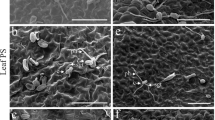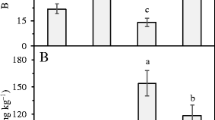Abstract
A single spray of solutions of 0.005M H3BO3, 0.0025M CuSO4, and 0.0025 MnCl2, on the upper surface of the first true leaf of cucumber plants 2 h before inoculation with a conidial suspension of Sphaerotheca fuliginea, induced systemic protection against powdery mildew in leaves 2 and 3 without causing any damage on the induced leaf (first leaf). A similar level of systemic protection was observed when plants were induced by micronutrients, 2, 24 and 72 h before challenge with S. fuliginea. The level of protection induced by various concentrations varied from solution to solution. In general, the systemic protection induced by K2HPO4 was similar to that by the microelements. Spraying of a 1:1 mixture of phosphate and micronutrient solutions did not improve the systemic protection over that obtained with each of the solutions alone. Increasing the inoculum concentration of S. fuliginea increased the number of powdery mildew colonies produced on both induced and non-induced plants and has relatively affected the systemic protection on induced plants. A single foliar spray of micronutrient solutions, as a prophylactic treatment, on the upper surface of all the leaves of 3-leaf stage cucumber plants significantly inhibited powdery mildew development. A single spray of MnCl2 on leaf 1 elevated peroxidase activity in the soluble fraction and caused an enhancement of β-1,3-glucanase content in the ionically bound fractions of leaf 2 of non-inoculated plants. Forty-eight hours after inoculation, the level of both fractions of the enzymes increased in non-treated plants and decreased (β-1,3-glucanase) or remained unchanged (peroxidase) in treated (induced) plants as compared to non-treated plants. The possible mechanism for this protection, and the use of microelements and phosphate solutions as inducers for systemic protection and as agents for disease control are discussed.
Similar content being viewed by others
References
Abeles FB and Forrence IE (1970) Temporal and hormonal control of β-1,3 glucanase in Phaseolus vulgaris L. Plant Physiology 45: 395–400
Abood JK, Losel DM and Ayres PG (1991) Lithium chloride and cucumber powdery mildew infection. Plant Pathology 40: 108–117
Cherif M, Asselin A and Belanger RR (1994) Defense responses induced by soluble silicon in cucumber roots infected by Pythium spp. Phytopathology 84: 236–242
Conway WS, Sames CE Abbott J and Bruton BD (1991) Post-harvest calcium treatment of apple fruit provides broad-spectrum protection against post-harvest pathogens. Plant Disease 75: 620–622.
Fowler JL and Morgan PW (1972) The relationship of peroxidative indole acetic acid oxidase system to in vitro ethylene synthesis. Plant Physiology 49: 555–559
Gottstein HD and Kuc' JA (1989) Induction of systemic resistance to anthracnose in cucumber by phosphates. Phytopathology 79: 176–179
Graham RD (1983) Effects of nutrient stress on susceptibility of plants to disease with particular reference to the trace elements. Advances in Botanical Research 10: 221–276
Huber DM (1981) The use of fertilizers and organic amendments in control of plant disease. In: Pimentel D (ed.) Handbook of Pest Management in Agriculture. Vol 1 (pp 357–394) CRC Press, Boca Raton, Florida, USA
Irving HR and Kuc' J (1990) Local and systemic induction of peroxidase, chitinase and resistance in cucumber plants by K2 HPO4. Physiological and Molecular Plant Pathology 37: 355–366
Kent NL (1941) The influence of lithium salts on certain cultivated plants and their parasitic diseases. Annals of Applied Biology 289: 189–209
Mucharromah E and Kuc' J (1991) Oxalates and phosphates induce systemic resistance against diseases caused by fungi, bacteria and viruses in cucumber. Crop Protection 10: 265–270
Murray DC and Walters DR (1992) Increased photosynthesis and resistance to rust infection in upper, uninfected leaves of rusted broad bean (Vicia fabia L.). New Phytologist 120: 235–242
Pennazio S and Roggero P (1988) Effects of trace elements on the natural resistance of asparagus bean to tobacco necrosis virus and ethylene production. Advances in Horticultural Science 2: 23–26
Reuveni M, Agapov V and Reuveni R (1993) Induction of systemic resistance to powdery mildew and growth increase in cucumber by phosphates. Biological Agriculture & Horticulture 9: 305–315
Reuveni M, Agapov V and Reuveni R (1995a) Suppression of cucumber powdery mildew (Sphaerotheca fuliginea) by foliar spray of phosphate and potassium salts. Plant Pathology 44: 31–39
Reuveni M, Agapov V and Reuveni R (1995b) Induced systemic protection to powdery mildew in cucumber plants by phosphate and potassium salts: effects of inoculum concentration and post-inoculation treatment. Canadian Journal of Plant Patholology 17: 247–251
Reuveni M, Agapov V and Reuveni R (1996) Controlling powdery mildew fungus (Sphaerotheca fuliginea) in cucumber by foliar sprays of phosphate and potassium salts. Crop Protection 15: 49–53
Reuveni M and Reuveni R (1995a) Efficacy of foliar application of phosphates in controlling powdery mildew fungus on field-grown winegrapes: effects on cluster yield and peroxidase activity in berries. Journal of Phytopathology 143: 21–25.
Reuveni M and Reuveni R (1995b) Efficacy of foliar sprays of phosphates in controlling powdery mildews in field-grown nectarine, mango trees and grapevines. Crop Protection 14: 311–314
Reuveni R, Agapov V and Reuveni M (1994a) Foliar spray of phosphates induces growth increase and systemic resistance to Puccinia sorghi in maize. Plant Pathology 43: 245–250
Reuveni R, Agapov V Reuveni M and Raviv M (1994b) Effects of foliar sprays of phosphates on powdery mildew (Sphaerotheca pannosa) of roses. Journal of Phytopathology (Berlin) 142: 331–337
Reuveni R and Perl M (1979) Peroxidase isoenzyme specifity in abscission zone fragments of pepper leaves affected by powdery mildew or stress conditions. Phytopathologische Zeitschrift 96: 208–214
Reuveni R, Reuveni M and Agapov V (1994c) Induction of growth increase and systemic resistance to Exserohilum turcicum in maize by foliar spray of phosphates. Journal of Phytopathology (Berlin) 141: 337–346
Reuveni R, Reuveni M and Agapov V (1996) Foliar sprays of NPK fertilizers induce systemic protection against Puccinia sorghi and Exserohilum turcicum and growth enhancement in maize. European Journal of Plant Pathology 102: 339–348
Schneider-Muller S, Kurosaki F and Nishi A (1994) Role of salicylic acid and intracellular Ca 2+ in the induction of chitinase activity in carrot suspension culture. Physiological and Molecular Plant Pathology 45: 101–109
Yalpani N, Silverman P, Wilson TMA, Kleir DA and Raskin I (1991) Salicylic acid is asystemic signal and inducer of pathogenesis-related proteins in virus infected tobacco. Plant Cell 3: 809–818
Yarwood CE (1954) Zn increases susceptibility of bean leaves to tobacco mosaic virus. Phytopathology 44: 230–232
Ye XS, Strobel N and Kuc' J (1995) Induced systemic resistance (ISR): Activation of natural defense mechanisms for plant disease control as part of integrated pest management (IPM). In: Reuveni R (ed.) Novel Approaches to Integrated Pest Management (pp 95–113) CRC Press, Boca Raton, Florida, USA
Author information
Authors and Affiliations
Rights and permissions
About this article
Cite this article
Reuveni, M., Agapov, V. & Reuveni*, R. A foliar spray of micronutrient solutions induces local and systemic protection against powdery mildew (Sphaerotheca fuliginia) in cucumber plants. European Journal of Plant Pathology 103, 581–588 (1997). https://doi.org/10.1023/A:1008671630687
Issue Date:
DOI: https://doi.org/10.1023/A:1008671630687




